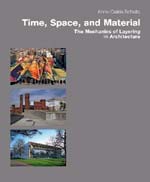
|

|
|
Home Site Search Contact Us Subscribe
|
|
Book Review: Clarifying The Art of Layering Space, or How Architects Outdo Superman's X-Ray Vision Daily In "Time, Space, and Material: The Mechanics of Layering in Architecture," Anne-Catrin Schultz provocatively illuminates essentials of architectural layering, storytelling, interpretation, and wonder that are concentrated in the acts of creating and appreciating architecture, layer after layer. By Norman Weinstein October 8, 2015 What is so wildly riveting about the capacity of a comic book or cinematic Superman to see through buildings? Beyond glimpses of fleeting prurient interest, it must be that thrill of penetrating façades to experience what we sense buildings, and those inhabiting their spaces, are at their core. A common idiom is instructive: when we complain about encountering someone’s façade at a social occasion, we’re frustrated by their intense maintenance of a front interfering with our learning who they really are in their deeps. Friendship and love we often verbalize as “seeing beyond surfaces,” and compare seeing the other as entailing a process akin to “peeling the layers of an onion,” a phrase equally germane to architecture.
When our architectural vision moves beyond façades, the notion of “layering” arises in immensely more varieties than simply onion-like. “Layering,” as Anne-Catrin Schultz writes in her invaluable new book, Time, Space, and Material: The Mechanics of Layering in Architecture (Edition Axel Menges), is “a term commonly used but rarely defined.” Within this well-illustrated 80-page overview of layering, Schultz offers both definitions as well as a well-curated range of architectural examples spanning centuries, from the 2000-year-old Duomo in the Italian city of Syracuse to Thom Mayne’s 2009 academic building on the Cooper Union campus in New York City.
In order to clarify a notoriously complex and slippery notion like layering, Schultz advances beyond the purely material definition of architectural layering offered by Stewart Brand in How Buildings Learn: What Happens After They’re Built. Brand elaborates on a concept of "shearing layers" invented by U.K. architect Frank Duffy. Duffy's “shearing layers” offers a layer-cake vision of the interplay of skin, structure, services, and site, emphasizing the different longevities of each. Schultz significantly expands layering by categorizing it into three varieties: temporal, spatial, and material, allowing these categories to occasionally overlap. Additionally, and brilliantly, Schultz notes how architecture comprises invisible yet essential layers of cultural and interpretative layers.
While this framework for layering may sound heady, it actually aids in seeing layering as an astonishingly rich compositional strategy. Her book makes evident a wealth of design possibilities few architects envision fully. She gives one telling instance of layering taken for granted in a limited fashion:
Architectural CAD drawings and digital representations frequently are structured by systems of layers pertaining to topic areas with the project to be turned on and off as needed, creating the...possibility of layering.
What digital displays of design layers can’t reveal are the invisible cultural and interpretative layers, a point she keenly makes in her analysis of the Syracuse Duomo, architecture that has metamorphosed over 2000 years from theater to fortress to apartment building. To begin thinking about a potential alteration for a building holding such a rich history invites a thoroughgoing, sensitive analysis of both material and immaterial layers. This kind of design mastery is exemplified by the subject of Schultz’s prior book, Carlo Scarpa: Layers, who she affectionately revisits in this book.
Although Schultz doesn’t suggest this term, I think her book is a primer for architects to intensify what I would call “long penetrative vision.” While AutoCAD offers the profession strikingly clear depictions of material project layers, only a penetrating vision mediated by an architect’s education, sensibility, and practice yields the full potential of layers of meaning. As she eloquently writes in defining her book’s focus:
These observations, in an attempt to put a face on a term that is commonly used but only rarely defined, reside in the spheres of narration, analysis, and speculation.
Put simply, storytelling, interpretation, and wonder are concentrated in the acts of creating and appreciating architecture, layer after layer. When architects do their work well in composing layers, they put a superhero’s “X-ray” vision to shame. To see through a building’s wall is only the start of an architectural odyssey.
Schultz’s book goes to the heart of what architectural layering is about, giving significance to what poet Cole Swensen magisterially identifies as “The infinite splitting of finite things.”
Norman Weinstein writes about architecture and design for Architectural Record, and is the author of “Words That Build” – an exclusive 21-part series published by ArchNewsNow.com – that focuses on the overlooked foundations of architecture: oral and written communication. He consults with architects and engineers interested in communicating more profitably; his webinars are available from ExecSense. He can be reached at nweinstein@q.com.
More by Weinstein:
An exclusive 21-part series that focuses on the overlooked foundations of architecture: oral and written communication.
Weinstein: From Ada to Zaha and Everything In Between Op-eds, book reviews, musings, and debate.
|
(click on pictures to enlarge) 
|
© 2015 ArchNewsNow.com